Recently, MyPillow CEO Mike Lindell shared that Minnesota Bank & Trust and its parent company Heartland Financial USA told him that
In a recorded call obtained by media, a senior bank executive reportedly characterized a continued relationship with Lindell as a “reputation risk.” The banker apparently said: “But what if somebody came in and said, 'You know what? We're going to subpoena all of his account records and this and that,' and we make the news?”
Well then, the question is: What if it did make the news?
Would other customers pull their business from the bank? Would politicians spur a boycott? Would investors question the competence of the bank’s leaders and start selling Heartland’s stock? What exactly was the reputational risk this banker was afraid of?
The most important question is: Did the bank actually know the answers to these other questions?
Reputation risk is not about “making the news.” It’s about stakeholder expectations. A reputational crisis occurs when a company fails to live up to those expectations and angry stakeholders react in tangible, material ways.
Reputation value is what stakeholders create when they act or spend money in the expectation of some future benefit. In banking, reputation value is what banking customers create when they expect — trust — their bank to hold their funds, account accurately and act ethically. Reputation value results in banks' being able to borrow on favorable terms and benefit from investors believing they are well governed, will grow, and will not run afoul of regulators. Reputation value is a factor when regulators forgive banks for inadvertent missteps rather than fining them heavily. Reputation value is built among social license holders, like politicians and community leaders, when banks support businesses that operate in their communities.
Reputation risk is a threat to that value, causing a loss of trust, and for banks, the diminution in access to capital. The run on banks in the 1930s is an extreme example of how reputation risk plays out among fearful, angry and disappointed bank customers. The creation of the Federal Deposit Insurance Corp. helped banks reassure customers that, with a little help if needed, they could meet stakeholder expectations for the security of their deposits.
It is possible that Mike Lindell’s bank understands that its stakeholders would be angry and disappointed to know that he was a customer. It is possible that customers would shun the bank, employees would seek work elsewhere, creditors would find it too risky and social license holders would make bank operations difficult. That would certainly create fertile grounds for reputation risk, and the sort of thing that would worry regulators.
But it is also possible that stakeholders would be indifferent. It is hard to know. These entities, in fact any companies, that want to manage reputation risk, would need to have an executive body keeping tabs on the expectations of all stakeholders. They would have a clear handle on what various stakeholder groups expected in terms of the bank’s vetting of other customers. And they would know the implications of disappointing any particular group. This reputation leadership team would inform the board of risks, and the board would approve the strategy for making tough calls — like severing ties with customers who are unpopular in some circles.
We don’t know if Heartland or Minnesota Bank & Trust had any such process in place, but the banker’s comments about making the news imply that it did not. Making the news is not a cause of a reputational crisis — it is a byproduct, a means of amplifying events.
At the same time, Lindell was likely wrong when he reportedly attributed the bank’s actions to “cancel culture.” The threat of reputation risk is so significant to the viability of banks and other financial institutions that more than two decades ago, banking regulators began requiring them to disclose publicly their reputation risk management strategies. Severing business ties for reasons of reputation risk is therefore a compliance decision reached through a process that should be overseen by a board of directors. If that is, indeed, what happened, it has nothing to do with the “cancel culture.”
Protecting reputation, building resilience into reputation, mitigates potential losses. Avoiding loss is strategic. As Benjamin Franklin once observed, “Glass, China and reputation are easily cracked, and never well mended.”
Protecting reputational value is at the heart of the notion of stakeholder capitalism, promoted vigorously by Larry Fink of BlackRock. More specifically, it is at the heart of the current corporate focus on environmental stewardship, social justice and dutiful governance known by the shorthand ESG.
Stakeholder capitalism is a recognition that the reputational value of every firm depends on that firm’s ability to meet stakeholder expectations. Of course, stakeholder groups have different priorities, do not necessarily agree with each other and may have expectations that are in direct conflict with the expectations of others. Thus, the need for a robust reputation risk management process.
We don’t know if Lindell’s banks have reputation leadership teams that contrasted the benefits and risks of continued business with Lindell with the benefits and risks of severing ties with Lindell — each with the potential for “making the news.” All we know at this time from public accounts is that they feared it. And that may be because they don’t really understand it as well as they should





